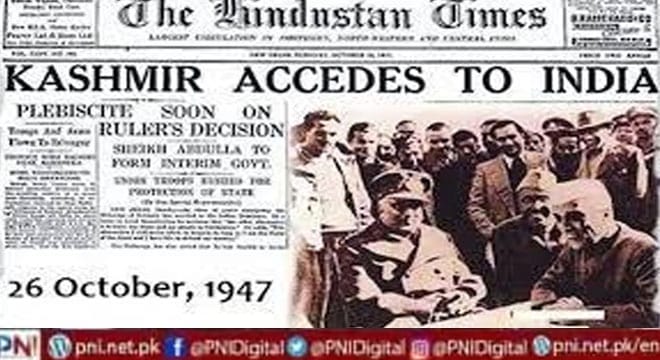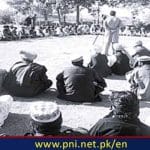’Kashmir accedes to India’’, this was the headline on the front page of Daily Hindustan Times dated on 28 Oct. 1947. Indeed, this line was not just a headline but in fact it was the outcome of dishonesty of Boundary Commission, tricks and traps of Pandit Jawahir Lal Nehru and Maharaja Harri Singh’s tilt towards India. The head of the state of J&K signed this instrument of annexation of Jammu & Kashmir with India by keeping aside the wishes and will of majority Muslim population of the state. In the meantime, uprising against the Maharaja’s tilt towards India was already started in the state by the Kashmiri peoples with the support of the Northern area tribal. The uprising in the state was the reaction of the events occurred and decisions made by the boundary commission, Pandit Nehru and Maharaja Hari Singh between the 3 Jun. 1947-22 Oct, 1947. In this period every move were made by these decision makers to accede the state Jammu & Kashmir with India.
Since the partition of subcontinent back in 1947-till now, the questions are still raising on the factuality instrument of accession. Even, if we consider this doubtful instrument of accession as a factual document than also the Moditva and Hindutva regime of the India has deviated this agreement with extreme unlawful legislations made on 5 august 2019. To understand the fact of mysterious history, we must need to know the facts that what were the circumstances which raised the uprising in the J&K and why the Maharaja ran to Dehli to sign this agreement.
On 3 June 1947, the plan for separation of subcontinent was formulated by the Briton’s in response of long-lasting movement for the creation of PAKISTAN. In continuity of 3 June plan, a boundary commission was established to decide the boundaries and accessions of princely states. As per plan of partition the state of J&K had also to decide either to go with India or with Pakistan. But the situation of the J&K was quite different from the other princely states, as the majority of the population of the state was Muslim while the ruler was a Hindu. So, before any decision making the ruler Maharaja Harri singh had to keep in mind the wish of own but also the will of the Muslim population.
Due to the religious similarity and the geographic structure the accession of J&K along with Pakistan was so natural. The first injustice and dishonesty of the Boundary Commission came in the form of annexation of Gurdaspur and Pathankot districts of Punjab to India, when Kashmir’s geographic ties with India was forcibly established. Remember that Gurdaspur was the area which links India and state of Kashmir. Thus, with this initiative an attempt was made to create a geographically favorable environment for the accession to India.
On the one hand; the Pro-India role of Mountbatten, Nehru’s tactics and pressure, Kashmiri Muslim leader Sheikh Abdullah’s inclination towards India- while on the other hand; the existence of a large Muslim population, the J&K political party Muslim Conference’s resolutions in favor of accession with Pakistan and state geographical ties with Pakistan were facts which made it difficult for the Maharaja to reach to any conclusion and decision. On 12 August, the Maharaja offered Pakistan and India a Standstill agreement which sought to keep the state of Kashmir standstill as it was, instead of annexation. Pakistan signed this agreement on August 15 but India refused for this agreement.
Maharaja HS was willing to accede the state with the India but he was in wait of appropriate and circumstances. Gurdaspur’s annexation move, Nehru’s-Mountbatten decisions, India’s refusal to agree for the standstill agreement created unrest in the state’s Muslim population which led to the protests and rallies. In this situation, the Maharaja was apprehensive of a mutiny. The Maharaja started confiscating arms from all the Muslim Kashmiris who were in the British army and started distributing these arms among the local Hindus. All the Muslim officers were removed from the Dogra army. Martial law was imposed in Poonch and Mirpur. The Dogra government’s efforts to crack down and suppress public reaction did not go down.
After the crackdown, the public reaction intensified and tribal’s from Pakistan also started reaching out to help the Kashmiri Muslims. In this entire situation, Maharaja Hari Singh escaped and reached Delhi, where he formally appealed for military assistance from India to maintain his influence over the state. Mountbatten and Nehru made the military assistance conditional with the Instrument of accession. Than finally, this agreement was signed between the Maharaja Hari Singh,Pandit Nehru and Governor General of India and lastly ‘Kashmir acceded to India’’.
This accession treaty is controversial which can be determined from the comparative review of two famous books. VP Menon’s book published in ‘1968’ mentions the date of this agreement as ‘26 October 1947’ and the arrival of Indian troops in the valley on ‘27 October’, while the Prime Minister of the then princely state of J&K Mehr Chand Mahajan in his book ‘Looking behind’ published in 1963 states that this agreement was signed on ‘October 27’, while Indian troops entered in Kashmir on ‘October 26’. The difference in dates raises questions about the reality of this agreement.
After decades of keeping the accession document under wraps, India finally released few photos in 2016 in plight of Right of information. But the photos fueled more suspicions. The document further extended the discussion of dates. In these pictures, the month of August is clearly written and later, a line drawn with a pencil and it is written as October. This alteration raises the question as to how and how such a significant mistake was made in the important document which was supposed to be signed by the Governor General of India and the Head of the state of Jammu and Kashmir.
However, if this controversial agreement is to be considered as the factual then defense, communication and foreign affairs were given under the authority of India. Apart from these three areas, the state assembly got the authority in other matters of the state and even these powers were accepted by India. Under the Treaty of Accession between India and Maharaja Hari Singh, the state got complete freedom in constitution & legislation, land, job quota and fully autonomy in administrative matters.
In the light of these points of the accession agreement, Article 370 and 35A became the part of the Indian Constitution. The Indian Prime Minister at that time Jawaharlal Nehru was a Kashmiri Pandit. During his tenure, Article 370 was added to the Indian Constitution. Under which the state got an independent Constituent Assembly, its own flag and a special status quite different from the other states of India. The final decision on any kind of constitutional amendment was subject to the approval of the J&K Assembly. While, Article 35A was added to the Indian Constitution in 1954, which prohibited non-Kashmiris from buying land in Kashmir.
Despite the disputed status of the Treaty of Accession, the state’s constitutional status and administrative autonomy were clear. However, after the inclusion of these clauses and the agreement with Hari Singh, let alone the observance of this agreement, a series of tinkering with the state’s constitution and identity began, which reached its peak on August 5, 2019, when India changed the constitutional status of Kashmir. This move put a final stamp on the measures to distort the identity of the state. As a result of the repeal of 35A, non-Kashmiris got the right to buy land in the state. The aim of this Indian effort is to settle some of the Hindu and Pandit population in the state in a manner similar to Israel’s settlement in Palestine, in such a way as to change the proportion of the majority Muslim population and influence a possible referendum approved by the United Nations.
By knowing all the facts of the history, it is known that in start with the annexation of Gurdaspur and then with the instrument of accession with India, the willingness of citizens of state of J&K was badly trampled. If Maharaja Hari Singh’s decision is to be accepted as righteous as the date of the accession and the date of entry of the Indian troops is also doubtful. If we consider this agreement as factual rather than controversial even than India abrogated this too. India not only abrogated this instrument of accession but also the resolutions of United Nation and unfulfilled the plebiscite promises of its very first Prime Minister Jawahir Lal Nehru. The Indian moves from the day one-till now are just to withhold the state of Jammu and Kashmir under its illegal occupation with the deployment of 800,000 troops. But these moves can never be successful in front of long-lasting resistance and sacrifices of Kashmiri peoples.
Follow the PNI Facebook page for the latest news and updates.








